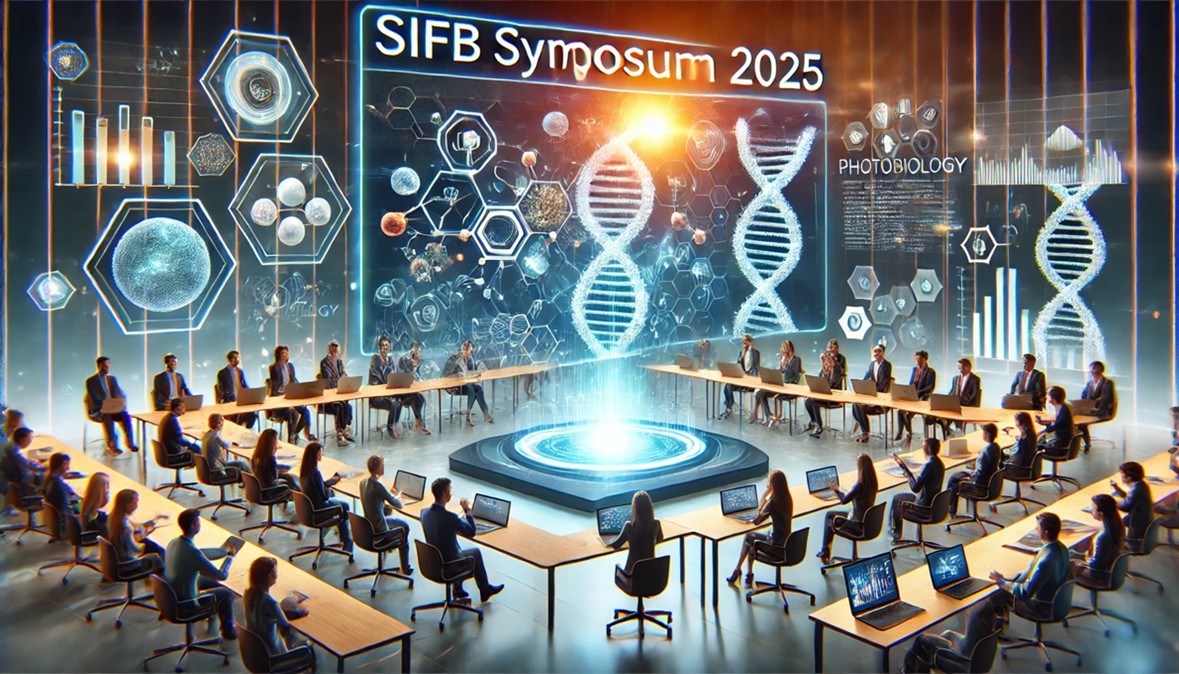Autore: SIFB_2022
Congresso IUPB-MEPSA 2024
Congresso IUPB-MEPSA 2024
ABSTRACT SUBMISSION DEADLINE EXTENDED UNTIL APRIL 14.
Congresso annuale 2007
IV Convegno Nazionale Congiunto di Fotobiologia e Fotochimica
Acquafredda di Maratea (Potenza), 6-9 giugno 2007
Comitato scientifico: Sebastiano Campagna, Gianfranco Canti, Maurizio D’Auria, Gianna Favaro, Francesco Ghetti, Giulio Jori
Comitato organizzatore: Maurizio D’Auria, Lucia Emanuele, Rocco Racioppi, Licia Viggiani, Enza Velluzzi
Scarica la circolare e il programma scientifico
Congress call
Call for Contributions: Single-Day SIFB Symposium (Online)

The “Single-Day SIFB Symposium” will take place online on Monday, April 7, 2025. This event aims to engage the entire photobiology community, with a special focus on giving ample space to presentations by young researchers.
Key Dates
- Abstract Submission and Registration Deadline: March 7, 2025
- Registration fee:
- Students, including Ph.D. candidates: no registration fee
- Italian young and senior researchers: only SIFB membership is mandatory. Please follow this link.
Event Highlights
- Keynote Speakers
Ardemis Boghossian, École polytechnique fédérale de Lausanne:
There’s Plenty of Room for Bioengineering Optical Nanosensors
Giuseppe Paternò, Politecnico di Milano
Phototaming of Bacterial Bioelectricity
Laura Bellia, Università degli Studi di Napoli Federico II
Santi Nonell, IQS-Universitat Ramon Llull
A Chemist turned Photobiologist. A miscelanea of highlights of my research career – and lessons I learned along the way
- Young Researcher Awards
The symposium will include the presentation of the two annual SIFB awards for outstanding young researchers.
- A research pitch session will allow participants to present their work in a 7-minute talk, followed by a 3-minute discussion.
- Participants are encouraged to present their research outcomes clearly and compellingly to engage the audience.
- Awards: Winners will receive a reimbursement of their registration fees for the ESP Congress in Bari.
The Scientific Committee will evaluate the presentation based on the following criteria:
Clarity and Effectiveness of Communication (50%)
- Ability to clearly convey complex concepts
- Logical structure and coherence of the presentation
- Engagement with the audience
Scientific Content and Relevance (30%)
- Depth and accuracy of the scientific information
- Relevance of the topic to the field of photobiology
Impact and Innovation (20%)
- Potential implications of the research presented
- Ability to inspire further discussion or new perspectives
Congress Brochure
Registration and abstact submission
To register, please complete and submit the Google Form provided at the bottom of this page by March 7, 2025.
- Abstract Submission Deadline: March 7, 2025
- Abstracts can be submitted directly through the same Google Form if you are logged in with a Gmail account.
- If you are not using a Gmail account, abstracts may be sent via email to info.at.sifb.it.
File Naming Instructions:
When submitting your abstract by email, ensure the file name follows this format:
Surname.Name.doc(x). The SIFB 2025 abstract template can be downloaded here.
organizing_scientific_commettee
Organizing Committee:
Greta Varchi, Istituto per la Sintesi Organica e la Fotoreattività, CNR
Carlo Matera, Dipartimento di Scienze Farmaceutiche Università degli Studi di Milano
Francesco Milano, Istituto di Scienze delle Produzioni Alimentari, CNR
Mariateresa Rossi, Università degli Studi di Brescia UO Dermatologia, ASST Spedali Civili di Brescia
Marzia Gariboldi, Dipartimento di Biotecnologie e Scienze della Vita Università degli Studi dell’Insubria, Varese
Matteo Di Giosia, Dipartimento di Chimica “Giacomo Ciamician” Alma Mater Studiorum – Università di Bologna
Maya Dimova Lambreva, Istituto per i Sistemi Biologici, CNR
Rossella Labarile, Istituto per i Processi Chimico Fisici, CNR
Sonia Visentin, Dipartimento di Biotecnologie Molecolari e Scienze per la Salute Università degli Studi di Torino
Scientific Committee
Ardemis Boghossian, École polytechnique fédérale de Lausanne
Giuseppe Paternò, Politecnico di Milano
Greta Varchi, Istituto per la Sintesi Organica e la Fotoreattività, CNR
Laura Bellia, Università degli Studi di Napoli Federico II
Marzia Gariboldi, Dipartimento di Biotecnologie e Scienze della Vita Università degli Studi dell’Insubria, Varese
Maya Dimova Lambreva, Istituto per i Sistemi Biologici, CNR
Rossella Labarile, Istituto per i Processi Chimico Fisici, CNR
Santiago Nonell Marugat, IQS-Universitat Ramon Llull
Sonia Visentin, Dipartimento di Biotecnologie Molecolari e Scienze per la Salute Università degli Studi di Torino
Valentina Rapozzi, Dipartimento di Scienze Mediche e Biologiche, Università di Udine
Venue congress
Predefined page for congresses with a physical venue
Programme
| From | To | Type | Name | Title | Chair/Moderators |
|---|---|---|---|---|---|
| 9:15 | 9:30 | Greta Varchi, SIFB President | Connection - Salutation | ||
| 9:30 | 10:20 | Invited | Ardemis Boghossian | There's Plenty of Room for Bioengineering Optical Nanosensors | Sonja Visentin |
| 10:20 | 10:40 | Talk | Federica Randisi | Synergistic Photodynamic and Chemotherapeutic Effects Using Ce6-Encapsulated in Folic Acid Decorated HSA Nanoparticles | |
| 10:40 | 11:00 | Talk | Thomas Lecuyer | Light activated strategies for cancer treatment | |
| 11:00 | 11:20 | BREAK | |||
| 11:20 | 11:40 | Talk | Elham Sattarinezhad | Exploring the Enzymatic Mechanism of Protochlorophyllide Oxidoreductase with Molecular Dynamics Simulations | Valentina Rapozzi |
| 11:40 | 12:10 | Invited | Laura Bellia | Lighting and Photobiology: the CIE role | |
| 12:10 | 13:00 | Invited | Giuseppe Paternò | Phototaming of Bacterial Bioelectricity | |
| 13:00 | 14:00 | BREAK | |||
| 14:00 | 14:50 | Invited | Santi Nonell Marrugat | Light and Life: A Chemist turned Photobiologist. A miscelanea of highlights of my research career – and lessons I learned along the way | Rossella Labarile |
| 14:50 | 15:00 | Award | Alessio Colleoni | Modulation of bacterial cell adhesion proteins via photoswitchable ligands: a promising strategy to counteract biofilm formation | |
| 15:00 | 15:20 | Award | Francesca Bianco | NIR pH-responsive PEGylated PLGA nanoparticles as effective phototoxic agents in resistant PDAC cells | |
| 15:10 | 15:30 | Award | Chiara Florindi | Amphiphilic membrane-targeted phototransducers for non-genetic optical stimulation of cellular bioelectricity | |
| 15:20 | 15:40 | Award | Alessia Lena | Application of Blue Light for the inactivation of planktonic and biofilm forms of Listeria monocytogenes | |
| 15:30 | 15:50 | Award | Benjamin Clépoint | “Green” Gold Nanostructures for Photothermal and Photodynamic Therapies | |
| 15:40 | 16:00 | Award | Asja Brovedani | Vanillin-Based Materials for Photoactivated Antimicrobial Applications | |
| 15:50 | 16:10 | BREAK | |||
| 16:10 | 16:20 | Award | David Grantz | Fully reversible control over DNA-intercalation with visible light | Marzia Gariboldi |
| 16:20 | 16:30 | Award | Michela Nigro | A newly designed phage-based nanobot for precision photodynamic and sonodynamic cancer therapy | |
| 16:30 | 16:40 | Award | Claudia Zonno | Effects of Deep Eutectic Solvents on the stability of chromatophores from Rhodobacter sphaeroides | |
| 16:40 | 16:50 | Award | Manuele Di Sante | Regenerative Efficacy of Biocompatible Carbon Nanoheaters | |
| 16:50 | 17:00 | Award | Andrea Martino | M13 Phage-Based Nanovectors as a Phototheranostic Platform for the Treatment of Ovarian Cancer | |
| 17:00 | 17:20 | Talk | Nayeli Fernanda Pérez Pérez | Photocontrol of behavior with photoswitchable ligands of α7 Nicotinic Acetylcholine Receptors | |
| 17:20 | 17:30 | BREAK | |||
| 17:30 | Announcement of the Young Researcher Awards |
Book of abstracts
The symposium book of abstracts can be downoaded here.
